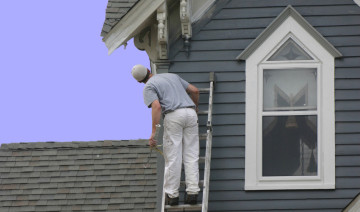
Prepping Your Home Exterior for Paint: A Comprehensive Guide
Giving your home a fresh coat of paint can breathe new life into its appearance and enhance its curb appeal. However, achieving a flawless finish starts with proper preparation of the exterior surfaces. In this blog post, we'll provide homeowners with a comprehensive guide on how to prep their home exterior for paint, ensuring a smooth and long-lasting finish that stands the test of time.
1. Clean the Surface:
Before painting, it's essential to clean the exterior surface thoroughly to remove dirt, grime, and mildew buildup. Use a pressure washer or a hose with a high-pressure nozzle to wash away dirt and debris. For stubborn stains or mildew, consider using a solution of water and mild detergent, followed by rinsing with clean water.
2. Repair Damaged Areas:
Inspect the exterior surface for any signs of damage, such as cracks, holes, or rotted wood. Fill in cracks and holes with a quality exterior filler or caulk, and replace any rotted wood with new material. Allow ample time for the repairs to dry completely before proceeding to the next step.
3. Scrape and Sand:
To ensure proper adhesion of the paint, it's essential to remove any loose or peeling paint from the surface. Use a scraper or wire brush to scrape away flaking paint, and then sand the surface smooth with medium-grit sandpaper. Be sure to feather the edges of the scraped areas to blend them seamlessly with the surrounding surface.
4. Prime Bare Wood:
If you've exposed bare wood during the scraping and sanding process, it's crucial to prime it before applying paint. Choose a high-quality exterior primer specifically formulated for bare wood, and apply it evenly to the primed areas using a brush or roller. Allow the primer to dry completely before proceeding to the next step.
5. Protect Surrounding Areas:
Before painting, take steps to protect surrounding areas from paint splatter and overspray. Cover windows, doors, trim, and other surfaces with plastic sheeting or drop cloths, and use painter's tape to mask off areas that you don't want to paint. This will help ensure clean lines and a professional-looking finish.
6. Choose the Right Paint:
Selecting the right paint is crucial for achieving a durable and long-lasting finish. Choose a high-quality exterior paint that is specifically formulated for the surface you're painting, whether it's wood, stucco, brick, or siding. Consider factors such as color, sheen, and durability when choosing your paint.
7. Apply the Paint:
Once the surface is properly prepped and protected, it's time to apply the paint. Use a high-quality brush or roller to apply the paint evenly, working in small sections and following the natural grain or direction of the surface. Apply multiple thin coats rather than one thick coat for best results, allowing ample drying time between coats.
8. Clean Up and Maintain:
After painting, clean up any tools and equipment used, and remove protective coverings from surrounding areas. Allow the paint to dry completely before removing tape or plastic sheeting. Once the paint has cured, be sure to maintain the exterior of your home by regularly cleaning and inspecting for any signs of damage or wear.
Conclusion:
Prepping your home exterior for paint is a crucial step in achieving a flawless finish that enhances its appearance and protects it from the elements. By following this comprehensive guide, homeowners can ensure that their exterior surfaces are properly prepped and primed for painting, resulting in a beautiful and long-lasting finish that adds value and curb appeal to their home.
